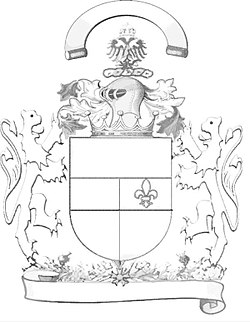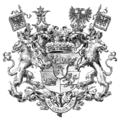Sign holder

In heraldry , human and animal figures located behind, next to or under the shield of a coat of arms , which are on a suitable base, a floor, lawn, cornice, console, pedestal , an ornamental tendril or similar are named as shield holders (previously also heraldic servant ) stand cultivate. Only angel figures are allowed to fly. They appear individually or in pairs, similar or different, next to or behind the shield, carry, hold or support it. This representation is often only common with the main coat of arms or the so-called Great Coat of Arms. The cohesion of the coat of arms is often underlined with the coat of arms tent (no coat of arms). There are other terms for shield holders: coat of arms holder, shield jack, coat of arms support and also guard.
The shield holder emerged from the seal . They served to enliven the open spaces on them. A seal with a coat of arms from 1195 is the oldest evidence of a shield holder. It shows a lion with a shield hung around his neck.
According to the heraldic rules, shield holders belong to the showpieces of a coat of arms. This means that they were originally not a firmly defined part of the full coat of arms . They made no additional statements about the owner of the coat of arms and were not dependent on specific rights. They only served as decoration and could be omitted at any time. They weren't hereditary either.
Another, less common, representation of shield holders is that in the coat of arms. Here they hold a smaller shield and then no longer belong to the gems, but they are counted as a common figure . Examples of this are the city arms of Kamenz and Brand-Erbisdorf .
Since the middle of the 17th century , however, it became customary to lend sign holders on a diplomatic and hereditary basis. A number of sovereign coats of arms also have specific shield holders, which are fixed once and for all by ordinances.
The wild men , depicted as naked, bearded, hairy, club-holding savages, who cover their pubic with a leaf or a belt of leaves, are widely used as shield holders or arms holders . These coat of arms holders are often tinged unheraldically in natural color. Other forms are saints or church representatives, who are often surrounded by a halo (nimbus). They often hold a crook or other sacred insignia.
The depiction of the holder is often done in such a way that they can hold lances , flags or crosses to enhance the coat of arms of animals in one hand or with the forefoot . It is not uncommon for medals or chains to be hung around them.
Of the heraldic animals , for example, the lions , unicorns , griffins or bears are often used. The mystical heraldic animals are especially in use. When blazoning , the attitude and the direction of the animals must be observed and follow the rules of the sign description. You can climb, stand, jump at the sign and look at the viewer (en face), stand against or turn back. Often the sign holder is crowned. Lying figures are rarely taken. The tinging is subject to the heraldic color rules. If many helmets are placed on the main shield, it has become common practice that the outer helmets are placed on the shield holders.
In England , the shield holders are considered special decorations that are still officially awarded.
The four coat of arms holders of the Icelandic national coat of arms are called land guards . There are bull , eagle , dragon and viking . The legend tells that these shield holders protected the island from the king of the Danes.
Examples
Large coat of arms of Bavaria : two lions
Older coat of arms of Hungary : two angels
Coat of arms of Baden-Württemberg : Württemberg stag and Baden griffin
Bassum u. a. with wall crown on a base
Coat of arms of Count Finck von Finckenstein : two lions
Coat of arms of Basel : a basilisk (original mirrored)
Late romantic depiction of the coat of arms of a student union (1844) with a knight
Coat of arms of the city of Kamenz with shield holder as a common figure
United Kingdom coat of arms : lion and unicorn (unofficial tracing)
Large coat of arms of Prussia : two men
Zaanstad shows a pair of whales
literature
- Walter Leonhard : The great book of heraldic art. Development, elements, motifs, design. 2nd revised and expanded edition. Callwey, Munich 1978, ISBN 3-7667-0345-5 .
- Heinrich Hussmann : About German heraldic art. Pressler, Wiesbaden 1973.
- Gottfried Daniel Hoffmann: About the coat of arms-shield-holder in particular of the Roman-German Empire-Eagle the two griffins. Heerbrandt, Tübingen 1779, digitized .




















